TIE1
-
Official Full Name
TIE1 tyrosine kinase with immunoglobulin-like and EGF-like domains 1
-
Synonyms
TIE1; tyrosine kinase with immunoglobulin-like and EGF-like domains 1; TIE, tyrosine kinase with immunoglobulin and epidermal growth factor homology domains 1; tyrosine-protein kinase receptor Tie-1; JTK14; tyrosine kinase with immunoglobulin and epidermal growth factor homology domains 1; TIE;
- Recombinant Proteins
- Cell & Tissue Lysates
- Antibody
- Protein Pre-coupled Magnetic Beads
- Human
- Mouse
- CHO
- E.coli
- HEK293
- HEK293T
- Human Cell
- Insect Cell
- Mammalian Cell
- Mammalian cells
- Mouse
- C
- His
- DDK|His
- Fc
- Fc|His
- HIgG
- His (Fc)
- Avi
- His|T7
- Myc
- DDK
- Myc|DDK
- N/A
- N
- Background
- Quality Guarantee
- Case Study
- Involved Pathway
- Protein Function
- Interacting Protein
- TIE1 Related Articles
- TIE1 Related Research Area
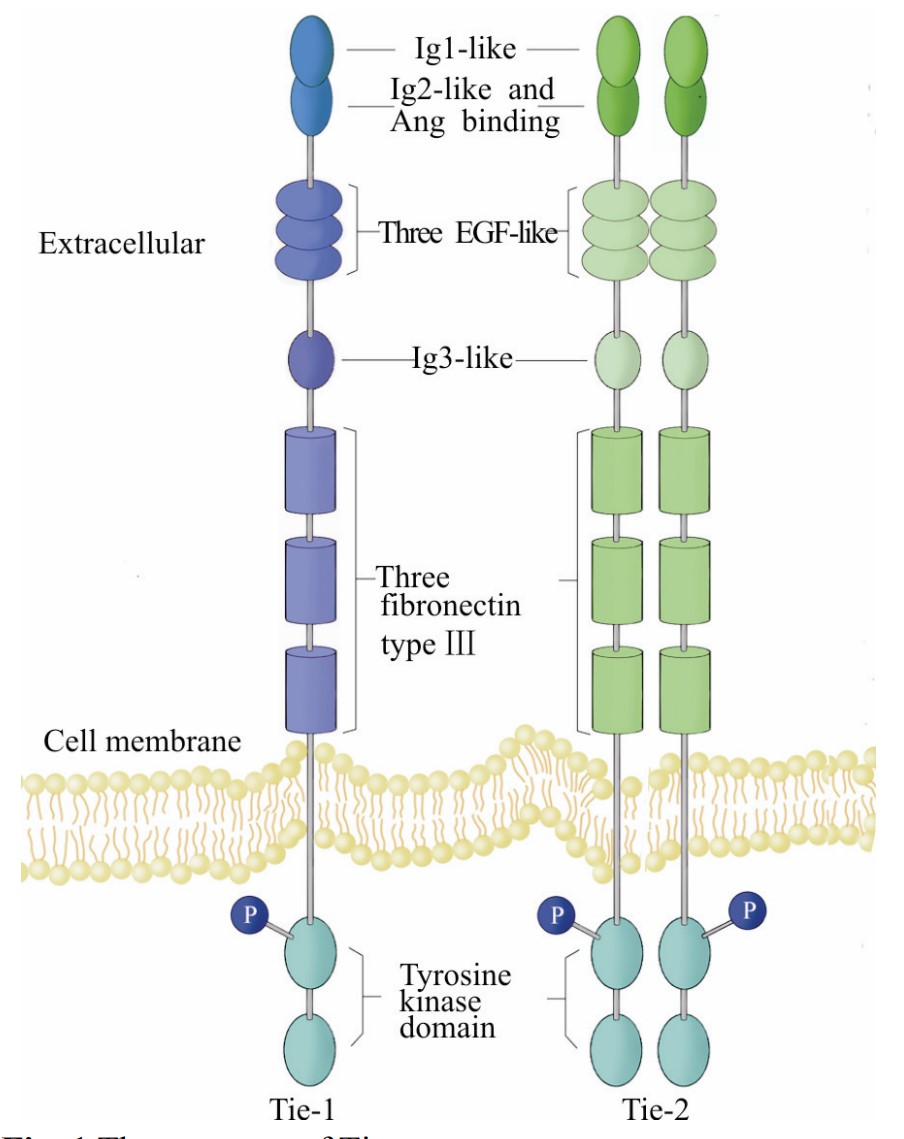
Fig1. The structure of Tie receptor Tie. (Ping Yang, 2015)
What is TIE1 protein?
TIE1 (tyrosine kinase with immunoglobulin like and EGF like domains 1) gene is a protein coding gene which situated on the short arm of chromosome 1 at locus 1p34. This gene encodes a member of the tyrosine protein kinase family. The encoded protein plays a critical role in angiogenesis and blood vessel stability by inhibiting angiopoietin 1 signaling through the endothelial receptor tyrosine kinase Tie2. Ectodomain cleavage of the encoded protein relieves inhibition of Tie2 and is mediated by multiple factors including vascular endothelial growth factor. The TIE1 protein is consisted of 1138 amino acids and its molecular mass is approximately 125.1 kDa.
What is the function of TIE1 protein?
TIE1 protein is a receptor tyrosine kinase mainly expressed in vascular endothelial cells. After binding to its ligand ANGIOPOIETIN, TIE1 protein is involved in regulating physiological processes such as angiogenesis, vascular stability and vascular permeability. Specifically, TIE1 protein, by binding to ANGIOPOIETIN 1, can promote the recruitment of vascular smooth muscle cells and the stability of vascular basement membrane, thereby maintaining the resting state of blood vessels; Binding to ANGIOPOIETIN 2 disrupts vascular stability and increases vascular permeability, which plays an important role in pathological processes such as inflammation and tumor growth.
TIE1 Related Signaling Pathway
TIE1 is a tyrosine kinase receptor that is mainly expressed in vascular endothelial cells. It interacts with its ligand Angiopoietin to regulate angiogenesis and maturation. The Ang1-TIE2-TEK signaling pathway is the main signaling pathway related to TIE1 protein. When Ang1 binds to TIE2, it can activate TEK (also known as TIE1), which promotes the survival, stability, and maturation of endothelial cells. In addition, this signaling pathway also interacts with a variety of other signaling pathways, such as PI3K/AKT, MAPK, etc., to further regulate cell function.
TIE1 Related Diseases
TIE1 protein abnormalities may lead to a range of vascular related diseases, such as tumors, diabetic retinopathy, atherosclerosis, etc. In addition, the TIE1 protein is also critical for the regulation of angiogenesis during embryonic development, so its abnormality may be associated with certain congenital vascular malformations.
Bioapplications of TIE1
TIE1 protein is a molecular target with wide application prospects in tumor therapy, immune regulation, cardiovascular system disease treatment and other fields. Some anti-tumor drugs use it to block the development of tumors; The development of immunosuppressants targeting it can effectively delay the development of inflammation.
High Purity
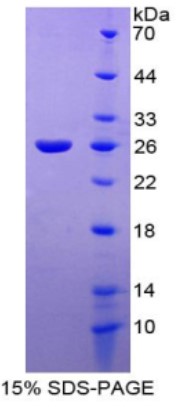
Fig1. SDS-PAGE (TIE1-533H) (PROTOCOL for western blot)
.
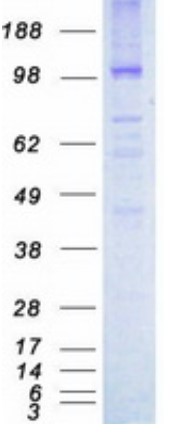
Fig2. SDS-PAGE (TIE1-4846H) (PROTOCOL for western blot)
Case Study 1: Tomoka Misawa, 2021
Ovarian cancer is the most lethal gynecologic malignancy due to the tumor's acquisition of chemoresistance to platinum-based chemotherapy. To solve this problem, we conducted RNAi-based large-scale screening and determined that tyrosine kinase with immunoglobulin-like and EGF-like domains 1 (TIE-1) is a key molecule involved in the platinum resistance of ovarian cancer cells. Recently, a variety of studies have investigated that small extracellular vesicles (sEVs) contribute to the communication between cancer cells, including the development of chemoresistance in ovarian cancer.
TIE-1-overexpressed TOV112D cells, termed TOV112DTIE-1 cells, were established, and sEVs were isolated from TOV112DTIE-1 cells supernatants by ultracentrifugation. The researchers assessed cisplatin sensitivity in recipient cells with TOV112DTIE-1-derived sEVs by cell-Titer Glo kit. They also asked whether sEV-derived TIE-1 suppressed the DNA damage response in recipient cells and evaluated the DNA damage response by counting cells positive for DNA damage foci. TIE-1 was contained within sEVTIE-1 derived from the cellular supernatant of TOV112DTIE-1. They showed that sEV-derived TIE-1 decreased chemosensitivity to cisplatin by suppressing the DNA damage response in recipient cells.
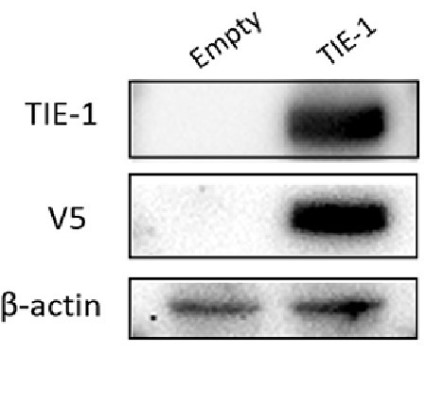
Fig1. Immunoblotting for TIE-1, V5 and β-actin in whole cell lysates.
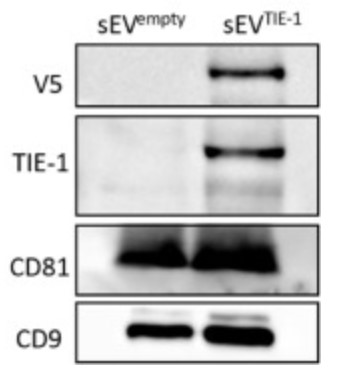
Case Study 2: Julie Garcia, 2012
Endothelial-mesenchymal transition (EndMT) has a significant role in embryonic heart formation and in various pathologies. However, the molecular mechanisms that regulate EndMT induction remain to be elucidated. The researchers show that suppression of receptor tyrosine kinase Tie1 but not Tie2 induces human endothelial cells to undergo EndMT and that Slug deficiency reverts this process. They find that Erk1/2, Erk5 and Akt cascades control Slug promoter activity induced by Tie1 deficiency. Interestingly, EndMT is present in human pancreatic tumour. They propose that EndMT associated with Tie1 downregulation participates in the pathological development of stroma observed in tumours.
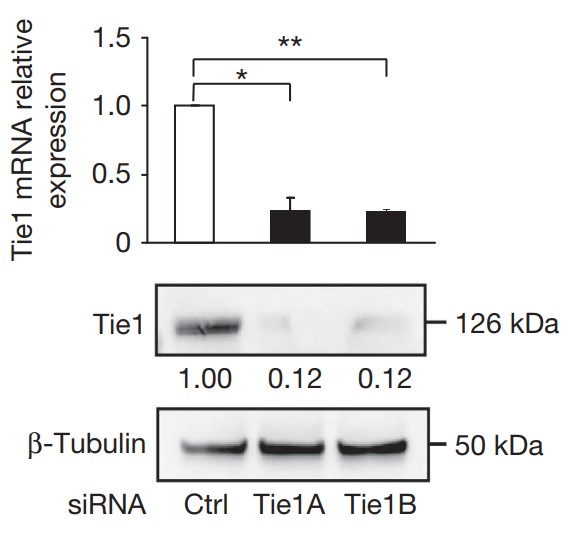
Fig3. Tie1 (left panel) or Tie2 (right panel) siRNA suppresses mRNA and protein expression.
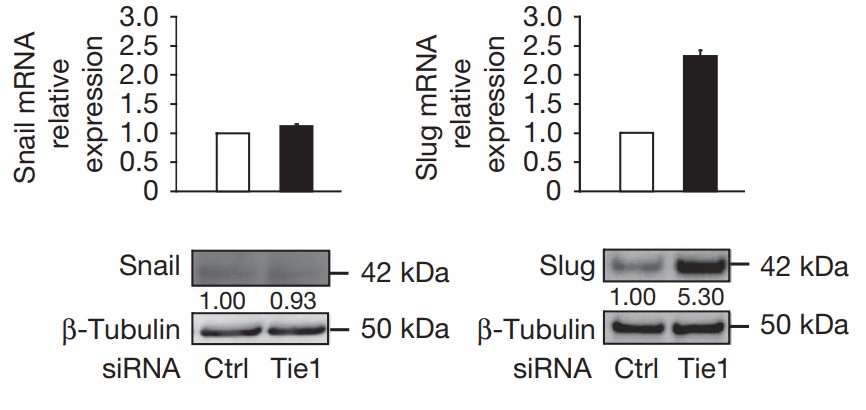
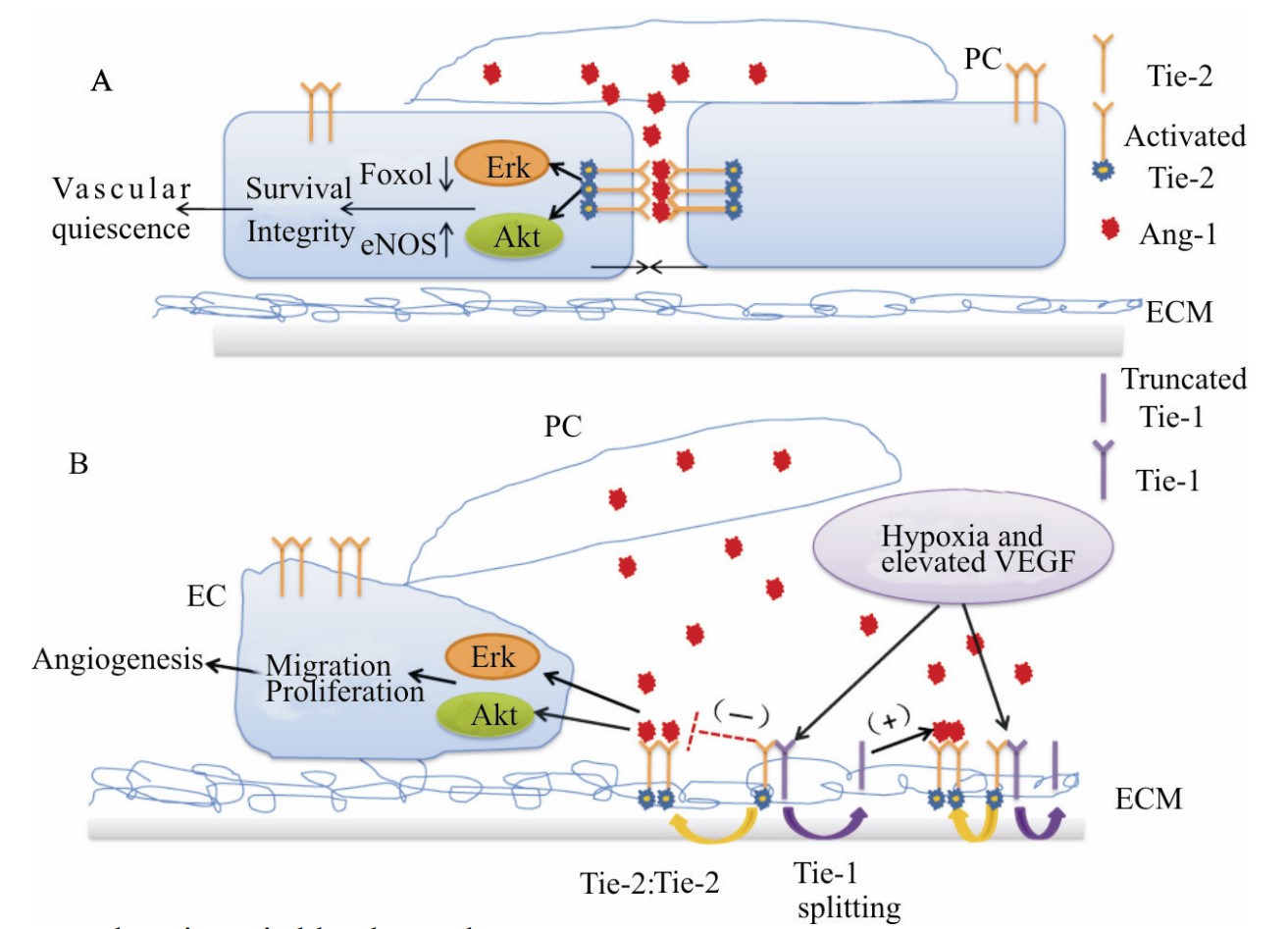
Fig1. Tie-1 in quiescent and angiogenic blood vessels. (Ping Yang, 2015)
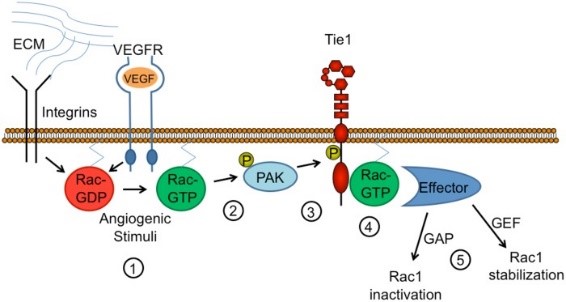
Fig2. Proposed model for Tie1-T794 phosphorylation by Rac1/PAK1 and modulation of Rac1 signaling. (Jessica L Reinardy, 2015)
TIE1 involved in several pathways and played different roles in them. We selected most pathways TIE1 participated on our site, such as , which may be useful for your reference. Also, other proteins which involved in the same pathway with TIE1 were listed below. Creative BioMart supplied nearly all the proteins listed, you can search them on our site.
| Pathway Name | Pathway Related Protein |
|---|
TIE1 has several biochemical functions, for example, ATP binding, protein binding, transmembrane receptor protein tyrosine kinase activity. Some of the functions are cooperated with other proteins, some of the functions could acted by TIE1 itself. We selected most functions TIE1 had, and list some proteins which have the same functions with TIE1. You can find most of the proteins on our site.
| Function | Related Protein |
|---|---|
| ATP binding | SGK2B;SUCLA2;INSRR;DYRK4;DAK;MB21D1;SYN2A;GSK3B;HLCS |
| protein binding | BTF3;CTC1;MAB21L1;PDGFRB;DDL-2;MLLT6;ABT1;USHBP1;BORA |
| transmembrane receptor protein tyrosine kinase activity | MUSK;IGF1RB;NPTN;EPHA2A;ROR1;ROS1;ERBB4;EPHB3A;ERBB3A |
TIE1 has direct interactions with proteins and molecules. Those interactions were detected by several methods such as yeast two hybrid, co-IP, pull-down and so on. We selected proteins and molecules interacted with TIE1 here. Most of them are supplied by our site. Hope this information will be useful for your research of TIE1.
KRT40; RBPMS; PSG5; MDFI; PTPRC; PTPRG; Dlg4; PTPRJ; HSP90AB1; CDC37
- Q&As
- Reviews
Q&As (6)
Ask a questionAt present, there is no direct way to increase the expression level of TIE1 protein, but it can be improved by regulating gene expression and providing nutritional support.
This protein can be used as a target for the development of new drugs, or as a drug carrier for the targeted delivery of drugs.
TIE1 is currently in clinical trials, including small molecule inhibitors against TIE1 and inhibitors against the TIE1 signaling pathway.
In clinical practice, the expression level of TIE1 can be detected to predict disease progression and prognosis, and to guide the choice of treatment regimen. For example, in the diagnosis and treatment of angiogenesis-related diseases, measuring the expression level of TIE1 can help doctors determine the type, stage, and prognosis of the disease, and guide the choice of treatment regimen.
TIE1 protein can shed light on the mechanisms of angiogenesis and embryonic development, as well as the pathogenesis of certain angiogenesis-related diseases. In addition, it is of great significance for the development of new drugs and treatment strategies.
Studies have shown that TIE1 protein plays an important role in the pathogenesis of certain autoimmune diseases.
Customer Reviews (3)
Write a reviewAfter repeated use, it can also maintain the stability of the performance, which makes me more confident in the experimental results.
Green and pollution-free, it can be seen that the manufacturer is very environmentally conscious.
The range of applications is breathtaking, and it can play an important role in any field.
Ask a Question for All TIE1 Products
Required fields are marked with *
My Review for All TIE1 Products
Required fields are marked with *


